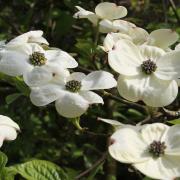In the latest in his series on intelligent plants, Martyn Baguley assesses whether plants have the ability to feel

I used to take groups of postgraduate landscape architecture students on ecology field trips. With their minds on higher planes like landscape design and lines of vision, most weren’t particularly interested in soil types and associated vegetation, until I took them to a piece of acid moorland, drew their attention to a small plant nestling amongst heather and told them it was carnivorous. ‘Higher planes’ were instantly forgotten and the students would cluster round, swat flies and drop them onto the diminutive plant to see what it did. Was that an expression of our baser instincts?
The plant was a sundew (Drosera rotundifolia - ‘Drosera’ from the Greek word droseros meaning ‘dewy’, from the appearance of glistening hairs on the leaves; ‘rotundifolia’ meaning round-leaved). Sundews have tentacles on their leaves with glandular heads that produce a sticky mucilage that reflects light and attracts insects. Once on the leaves the insects, stuck by the mucilage, struggle to escape which results in them becoming more covered in the mucilage. In no more than ten seconds their struggles stimulate the plant’s tentacles to bend inwards and the leaves to curl up, trapping the insects which are suffocated. The whole process takes about three minutes. Enzymes are then produced by the plant from glands and the insects are eventually digested. So there you have it – grisly, unquestionable evidence of one genus of plants ‘feeling’ the dying struggles of their insect prey.
Carnivorous plants are adapted to growing in places where soils are deficient, particularly in nitrogen, like acidic bogs, compensating for the deficiencies by trapping and digesting animal life. There are estimated to be some 200 species of Drosera worldwide (only one in Derbyshire - Round-leaved Sundew plants are rare but they can be found in areas of wet peat and sphagnum moss in the moorlands of the Dark Peak) and at least 583 other carnivorous plant species that attract, trap and kill prey, many of which deploy the sense of touch in the process. The biggest is a pitcher plant, Nepenthes raja, which grows in Malaysia and is said to be capable of trapping and digesting small mammals.
You won’t find many sundews in Derbyshire gardens, but you will find runner beans, honeysuckles, ivy, sweet peas, cucumbers and many other plants that exhibit what is called positive thigmotropism (from the Greek thigma ‘touch and tropos ‘turning’).
How climbing plants find supports had puzzled scientists since the 19th Century -predictably Charles Darwin studied it. It is a complex subject in itself involving many ‘isms’, but essentially when a plant’s tendril starts to grow it oscillates in the air (called circumnutation) as if searching for something to serve as a support. When it does contact a potential support, touched cells produce the plant hormone auxin which transfers to non-touched cells that then grow faster, causing the tendril to bend round the support.
And plant roots can be just as clever (excuse the anthropomorphism). When an embryonic root, called a radical, emerges from a seed it bends in the direction of gravity (It’s exhibiting another ‘ism’ – gravitropism). As it grows downwards, if the tip of the root encounters an obstruction like a stone an auxin gradient quickly becomes established across the root which causes cells on one side to grow more than on the other. This makes the root bend away from the obstruction. Fascinating isn’t it?
Responses to touch stimuli by both carnivorous and climbing plants can easily be seen but are the vast majority other plant species sensitive to touch?
In the early 1960s Frank Boyer, an American plant physiologist, was studying the flowering of a common weed called cocklebur (don’t ask me why). The study involved using a ruler to daily measure the lengths of leaves on plants in the field. He soon noticed that the leaves he measured stopped growing and eventually turned yellow and died, whereas leaves on the same plant that weren’t touched flourished. It took another ten years before Mark Jaffe, another American plant physiologist, proved that plants are very sensitive to touch and repeated touching can retard growth.
The subject took a leap forward in 2016 when the University of Western Australia published the results of research done by Olivier van Aken on plant responses to touch. ‘Although people generally assume plants don’t feel when they are being touched they are actually very sensitive to it’, Dr. Aken said. ‘While plants don’t appear to complain when we pinch a flower, step on them or just brush by them while going for a walk, they are fully aware of this contact and are rapidly responding to our treatment of them’.
Scientists have found that simply spraying water on plants causes changes to occur in genes in the plant’s cells that influence what they can do. The changes start within minutes of the stimulus and last for about thirty minutes. Some plants are more sensitive to touch than humans and even simply patting or touching them can trigger similar physiological responses. Unlike animals, plants can’t run away from harmful conditions so they have developed systems that enable them to sense their environment, detect danger and respond defensively.
By the 1970s scientists knew that if one leaf of a plant was damaged that activated genes in both the leaf itself and throughout the entire plant, including the roots. For years this was thought to be due to chemicals being transported in veins from the wounded leaf to the rest of the plant, but in the 1990s Professor Diana Bowles and a team working at Leeds University carried out some clever research that proved otherwise. They discovered that if a leaf of a tomato plant was burned with a hot steel block an electric signal could be detected in the stem of the plant well away from the wounded leaf. The signal could still be detected even when the petiole (leaf stalk) of the wounded leaf was frozen preventing any movement of chemicals but not electricity. The experiment showed convincingly that when a leaf of a tomato plant is burnt ‘watch-out-danger’ electric signals immediately course round the rest of the plant.
It is now well established that plants are very sensitive to touch and repeated touching can retard growth. Even the lightest of touches activates genetic defence responses; within thirty minutes of being touched ten percent of a plant’s genome is altered. Not only do plants know when they are being touched, they can distinguish between hot and cold, know when their branches are being swayed by the wind and even when they are being touched by neighbouring plants. In 2018 Dr. Yan Wang of Melbourne’s La Trobe University said that although we don’t yet know why plants react so strongly to touch, recent research has led to a deeper understanding of the defence mechanisms involved and this may lead to new ways of managing plants to optimise growth.
All this must be very disconcerting; particularly for vegetarians who assume that their dietary habits are nature-friendly. It may even be making you feel squeamish about picking flowers, pruning your roses or even cutting the lawn. If so relax. Scientists have found no evidence that plants feel pain. At least not so far.
Discover more Derbyshire stories and images via our social media pages - Facebook, Twitter and Instagram.



























